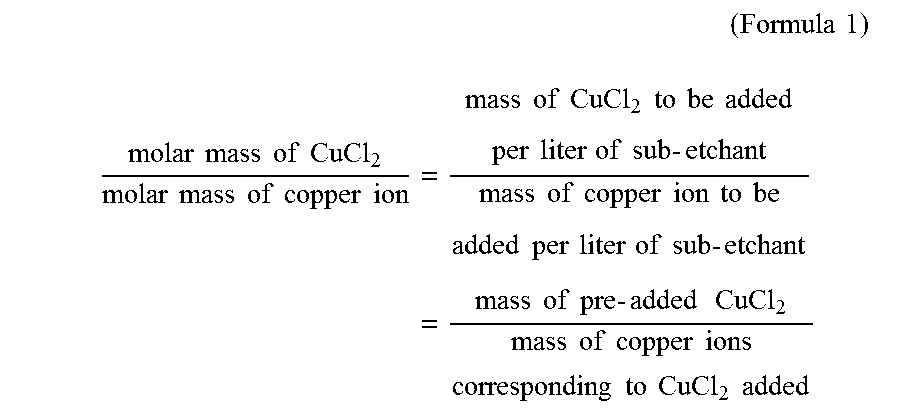High-Efficiency and High-Quality Acidic Cupric Chloride Etchant for Printed Circuit Board
a technology of acidic cupric chloride and printed circuit boards, which is applied in the direction of printed circuits, insulating layers/substrates, chemistry apparatuses and processes, etc., can solve the problems of unstable etching rate, difficult to ensure etching quality, and inability of ferrous chloride to etch copper in the copper etching process, etc., to ensure the safety of etching production
- Summary
- Abstract
- Description
- Claims
- Application Information
AI Technical Summary
Benefits of technology
Problems solved by technology
Method used
Image
Examples
embodiment 1
[0087]Step 1: at ambient temperature and pressure, according to the designated components and their mixing ratio as shown in Table 1 below, selected raw materials are dissolved in water to prepare the sub-etchant; hydrogen peroxide was selected as the oxidant, a 27.5% of H2O2 solution was prepared;
[0088]Step 2: B g of cupric chloride was added into per litre of the sub-etchant obtained in step 1; the added amount of cupric chloride was obtained by calculation according to the set value of the concentration of copper ions in the solution listed in Table 1:
(Formula1)molarmassofCuCl2molarmassofcopperion=massofCuCl2tobeaddedperliterofsub-etchantmassofcopperiontobeaddedperliterofsub-etchant=massofpre-addedCuCl2massofcopperioncorrespondingtoaddedCuCl2
[0089]Wherein the molar mass of cupric chloride is 134.5 g / mol; and the molar mass of copper ion is 63.5 g / mol. The mass of copper ion to be added into per litre of sub-etchant is 120 g according to the value specified in embodiment 1 of Tabl...
embodiments 2-4
[0095]The procedures of embodiment 1 were repeated respectively, using the designated content of each component and parameters of the automatic detection and charging control machine as specified in embodiments 2-4 of Table 1 below. Wherein in step 2, 2 g of cupric chloride was firstly added into per litre of the sub-etchant obtained in step 1, and then copper was added in order to allow the concentration of copper ions in the obtained solution to reach the value specified in embodiments 2-4 of Table 1 (i.e. 120 g / L). According to formula 1 and formula 2 described above, the mass of copper added was 120−(2×63.5÷134.5)=119 g.
[0096]In embodiments 1-3, the concentrations of dissociated hydrogen ions, the ORP values, the oxidant H2O2 solutions and the percentages by weight of etchant additive (namely NaCl and HCl) in the sub-etchant are the same, but the percentages by weight of FeCl3 are different. From the results of Table 2, it can be known that etching rate and etch factor are propo...
embodiment 5
[0098]The procedures of embodiment 1 were repeated respectively, using the designated content of each component and parameters of the automatic detection and charging control machine as specified in embodiment 5 of Table 1 below. Wherein in step 1, hydrogen peroxide was used as the oxidant, and was prepared into a solution of 50% H2O2; and in step 2, 254.2 g of cupric chloride was added into per litre of the sub-etchant obtained in step 1 to allow the concentration of copper ions in the obtained solution to reach the value specified in embodiment 5 of Table 1.
PUM
 Login to View More
Login to View More Abstract
Description
Claims
Application Information
 Login to View More
Login to View More - R&D
- Intellectual Property
- Life Sciences
- Materials
- Tech Scout
- Unparalleled Data Quality
- Higher Quality Content
- 60% Fewer Hallucinations
Browse by: Latest US Patents, China's latest patents, Technical Efficacy Thesaurus, Application Domain, Technology Topic, Popular Technical Reports.
© 2025 PatSnap. All rights reserved.Legal|Privacy policy|Modern Slavery Act Transparency Statement|Sitemap|About US| Contact US: help@patsnap.com



